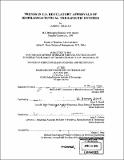| dc.contributor.advisor | Ernst R. Berndt and Issac S. Kohane. | en_US |
| dc.contributor.author | Graham, James B., 1976- | en_US |
| dc.contributor.other | Harvard University--MIT Division of Health Sciences and Technology. | en_US |
| dc.date.accessioned | 2006-03-24T18:36:00Z | |
| dc.date.available | 2006-03-24T18:36:00Z | |
| dc.date.copyright | 2005 | en_US |
| dc.date.issued | 2005 | en_US |
| dc.identifier.uri | http://hdl.handle.net/1721.1/30276 | |
| dc.description | Thesis (S.M.)--Harvard University--MIT Division of Health Sciences and Technology, 2005. | en_US |
| dc.description | Includes bibliographical references (p. 89-92). | en_US |
| dc.description.abstract | Pharmaceutical productivity, as measured by annual output of new molecular entities and new therapeutic biologics, has fallen significantly since reaching a peak in 1996. According to Food and Drug Administration (FDA) data, the number of new drug approvals (new molecular entities and new biologics) fell from 50 in 1996 to 29 in 2003 (FDA-BEP database 2004). Meanwhile, non-inflation adjusted expenditures for research and development have almost doubled (PhRMA 2004). This thesis uses time series analysis to characterize historical trends in new drug introductions. Linear modeling and ARIMA modeling are employed to show that the large increase in new drug approvals in 1996 is inconsistent with previous trends. The hypothesis that the 1996 increase in new drug approvals is the consequence of additional FDA processing capacity pursuant to the implementation of the Prescription Drug User Fee Act (PDUFA) is considered and rejected, based on an analysis of the underlying causes of the increase. Next, approval trends before and after the implementation of PDUFA are compared. Notably, the percentage of new drug applications resulting in approval has increased since the implementation of PDUFA while the number of applications reviewed per year has not changed significantly. The relationship between the success ratio and drug withdrawal rates is examined, with inconclusive results. | en_US |
| dc.description.abstract | (cont.) Finally, seasonal trends in new drug application (NDA) submissions and approvals are described for years preceding and following PDUFA. A significant plurality of NDA approvals occur in the month of December before and after the implementation of PDUFA, while December NDA submissions increase in the post-PDUFA period. The ramifications of these observations on new review guidelines introduced in PDUFA II and PDUFA III, as well as the implications for NDA submission strategy, are discussed. | en_US |
| dc.description.statementofresponsibility | by James B. Graham. | en_US |
| dc.format.extent | 100 p. | en_US |
| dc.format.extent | 5588605 bytes | |
| dc.format.extent | 5598867 bytes | |
| dc.format.mimetype | application/pdf | |
| dc.format.mimetype | application/pdf | |
| dc.language.iso | eng | en_US |
| dc.publisher | Massachusetts Institute of Technology | en_US |
| dc.rights | M.I.T. theses are protected by copyright. They may be viewed from this source for any purpose, but reproduction or distribution in any format is prohibited without written permission. See provided URL for inquiries about permission. | en_US |
| dc.rights.uri | http://dspace.mit.edu/handle/1721.1/7582 | |
| dc.subject | Harvard University--MIT Division of Health Sciences and Technology. | en_US |
| dc.title | Trends in U.S. regulatory approvals of the biopharmaceutical therapeutic entities | en_US |
| dc.title.alternative | Trends in United States regulatory approvals of the biopharmaceutical therapeutic entities | en_US |
| dc.type | Thesis | en_US |
| dc.description.degree | S.M. | en_US |
| dc.contributor.department | Harvard University--MIT Division of Health Sciences and Technology | |
| dc.identifier.oclc | 60847766 | en_US |
